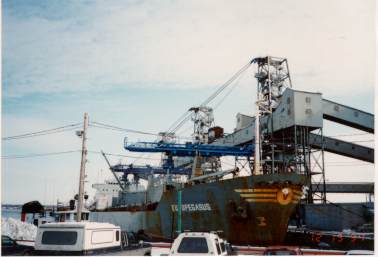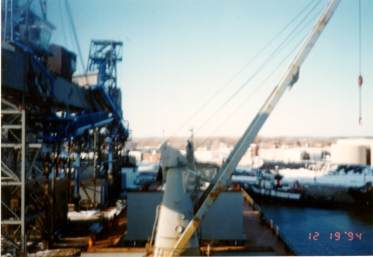Bottom contact
by the Cypriot bulk carrier "EUROPEGASUS"
Canal de la Rive Sud, Port of Montreal, Quebec
The Transportation Safety Board of Canada (TSB) investigated this occurrence for the purpose of advancing transportation safety. It is not the function of the Board to assign fault or determine civil or criminal liability. This report is not created for use in the context of legal, disciplinary or other proceedings. See Ownership and use of content. Masculine pronouns and position titles may be used to signify all genders to comply with the Canadian Transportation Accident Investigation and Safety Board Act (S.C. 1989, c. 3).
Summary
On 18 December 1994, the bulk carrier "EUROPEGASUS", laden with 16,677 metric tonnes of barley from Superior, Wisconsin, was under way in the Seaway bound for berth No. 94 in the Port of Montreal.
The "EUROPEGASUS" exited the St. Lambert Lock under the conduct of a Montreal harbour pilot and proceeded in the Canal de la Rive Sud. When the vessel was about three cables downstream of the end of the lock approach wall, she yawed to port. Although helm and main engine manoeuvres were carried out, the vessel struck the western edge of the canal. The bottom plating was slightly dented and adjacent supports were distorted. The vessel returned to the middle of the channel. There was no injury or pollution as a result of this occurrence.
Factual information
Particulars of the vessel
| Name | "EUROPEGASUS" |
|---|---|
| Port of registry | Limassol, Cyprus |
| Flag | Cypriot |
| Official number | 708422 |
| Type | Bulk carrier |
| Gross tonnage | 15,620 |
| Length | 175.65 m |
| Draught | Forward: 7.92 m Aft: 7.92 m |
| Built | Steel, 1972 |
| Propulsion | One M.A.N. engine, 8,238 kW, driving a single fixed-pitch propeller |
| Owners | Pearlboat Maritime Co. Ltd. Limassol, Cyprus |
While the vessel was in the St. Lambert Lock, the Montreal Vessel Traffic Centre (VTC) confirmed that berth No. 94 in the harbour was not available and that the vessel had to anchor off Pointe-aux-Trembles. The vessel requested access to the Montreal East anchorage, but the VTC could not confirm the availability of this anchorage before the vessel departed from the lock.
The "EUROPEGASUS" exited the lock in daylight in fair weather. Pilotage was done by visual observation.
At 0634Footnote 1, the pilot advised Seaway-Beauharnois that the vessel had reached the downstream end of the lock approach wall. The vessel then contacted the VTC to report her position. A radiotelephone conversation ensued over where the vessel would have to anchor in the harbour. The uninterrupted conversation was cut off abruptly at 0638.
The "EUROPEGASUS" yawed to port, and the helmsman put the helm hard-a-starboard, but the vessel did not respond. After being informed of the situation by the officer of the watch, the pilot ordered the helm hard-a-starboard and full speed ahead. It was pointed out to the pilot that the helm was already hard-a-starboard, but the vessel kept on yawing to port. The starboard anchor was ordered dropped, but there were no crew members on the forecastle. The pilot then ordered full speed astern. When the vessel was about three cables downstream of the lock approach wall, in position 4530′30″N, 7331′20″W, she struck the western edge of the channel and then swung to starboard.
When the vessel resumed a course parallel to the channel, the pilot ordered slow speed ahead, followed immediately by dead slow ahead. The vessel returned to the middle of the channel and exited the Canal de la Rive Sud without further incident.
The port authorities had reserved the Montreal East anchorage for a vessel downbound in the Seaway behind the "EUROPEGASUS". The VTC expected that berth No. 94 would not be free until 0800. The Montreal East anchorage lies off berth No. 94.
There were three vessels at the Pointe-aux-Trembles anchorage. The VTC expected them to depart at 0700. This anchorage lies downstream of berth No. 110.
The helmsman was using approximately 10 of helm to stay on course and was using the gyrocompass and landmarks as references.
Analysis
From experience, the pilot preferred not to manoeuvre in the vicinity of the Pointe-aux-Trembles anchorage early in the morning because of the heavy traffic caused by the departure of downbound vessels. When the VTC assigned the vessel to the Pointe-aux-Trembles anchorage, the pilot immediately asked about the availability of the Montreal East anchorage. Even though the pilot raised the possibility to VTC that the selection of the anchorage at Pointe-aux-Trembles could affect the safety of the ship and the vessel did not receive permission immediately to anchor at the Montreal East anchorage, the choice of anchorage could have been negociated after the vessel had left the confines of the narrow Seaway channel.
The pilot's primary task was the conduct of the vessel. When the radiotelephone conversation between the pilot and the VTC evolved into an argument, it increased the pilot's workload. A typically succinct conversation was not carried out and the pilot's attention was divided between conducting the vessel and pressing his arguments in order to obtain the Montreal East anchorage. The uninterrupted conversation prevented him from focussing his full attention on the conduct of the vessel.
The helmsman was using the gyrocompass and landmarks to determine the direction of the vessel in order to keep the vessel on track. Because of the good visibility in the confined waters of the Canal de la Rive Sud, he was able to make good use of landmarks rather than the gyrocompass, which had some directional response lag. Sustained concentration on the navigational equipment or a distraction prevented the helmsman from assessing in time the extent of the initial yaw.
Findings
- The pilot divided his attention between the conduct of the vessel and the uninterrupted radiotelephone conversation.
- The extent of the yaw was not assessed in time.
- The helm manoeuvres did not cancel the yaw.
- There were no crew members on the forecastle to drop the anchor.
- The engine manoeuvres did not prevent the vessel from striking the bottom.
Causes and Contributing Factors
The "EUROPEGASUS" struck the edge of the channel because an appropriate watch was not kept to stay on course. The helm and engine manoeuvres were not carried out in time to prevent the vessel from striking the bottom, and there was no one on the forecastle to drop the anchor.
This report concludes the Transportation Safety Board's investigation into this occurrence. Consequently, Chairperson John W. Stants and member Zita Brunet authorized the release of this report on , pending ratification by the full Board.

